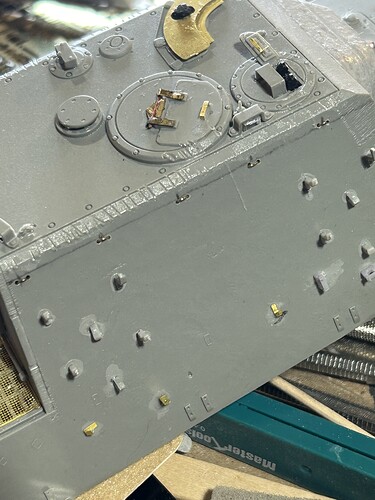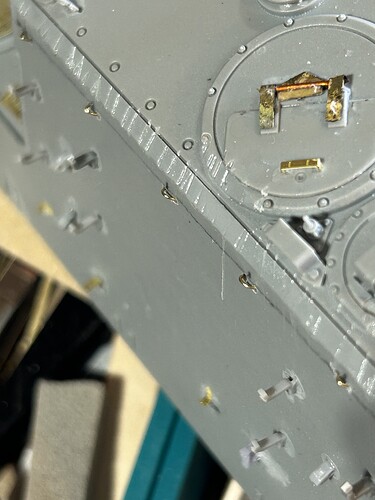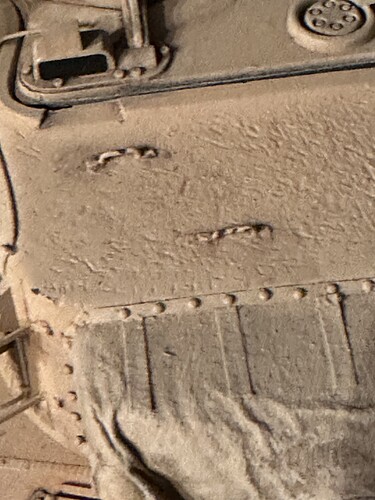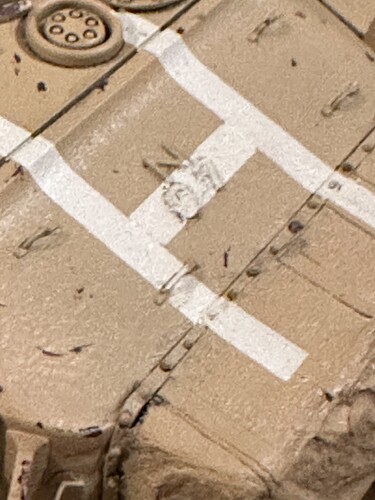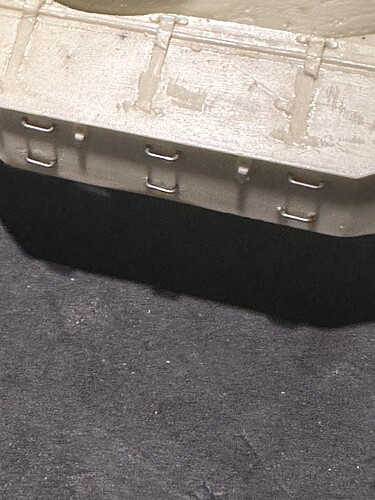dear colleagues: i’m sort of new to scale modeling (i don’t count the crappy Revell kits i destroyed as a kid in the 70’s). i came to it after a lifelong love of ww2 history and fascination. what got me at age 57 into it was convalescing after a major surgery. i’m a 90% service connected disabled Marine Corps veteran. So, i threw myself into the craft spending thousands on capitalizing the operation. it’s been about a year but i believe i’ve come a long way thanks to folks like you who are supportive and great artists. Anyway, one day i had it trying to bend little Aber tie downs to a model knowing that you couldn’t use those to seriously tie anything down. So, i thought of what i’d assumed was an idea (probably been done by others a billion times). i scaled up the wire, location and drilled two pin vise holes within 1/4mm. i then stitched the wire through, tied it off on the inside and glued for good measure. using German silk bead cord to scale one can really tie things down. Don’t laugh at the mess but i wanted to know your thoughts. idk. Maybe it’s been done to death but my mentor Lukasz from coldemonspl on YT inspired me to scratch build. what do you think?
It’s actually a pretty good idea.
Ken
Using wire for the tie downs guarantees you can actually tie things to them without them popping off.
For US and British style tie downs you can add the little “feet” to the ends where they would be welded on. These are absolutely functional:
Works on resin kits too, although I have not yet added the “feet” to these :
After you add the styrene feet, hit with multiple applications of liquid cement to give them a good “welded on” appearance.
Good idea, looking good.
The technique isn’t a bad one but I would use a smaller drill bit for the holes. I would bend the wire or use a homemade jig to get a more flat profile than a loop profile. A drilling jig wouldn’t be a bad idea either to ensure the spacing is consistent.
There are companies that make resin and 3D print tie downs that can added with CA/super glue.
If making your own, a few companies sells wire bending jigs to help make them consistent size. The feet can punched plastic and extra glue to represent welds.
HTH
As Ryan mentioned above, bending the wire into “staple” shapes will yield a nicer result. For a consistent size you probably already own a “jig.”
I use a pair of needle nosed pliers - the kind with serrations along the inside of the jaws. Place the wire inside the serrations and bend down both ends. Once you’ve found the serration that gives you the width that you want, just blacken it a little with a Sharpie so you can instantly index yourwire every time.
I can’t remember which gauge wire I use but it fits into no. 80 drill bit holes perfectly. Tightly in fact, so that I really don’t even need to apply CA on the inside any more.
My drilling jig is a set of dividers.
These US and British “tie downs” are referred to as “Footman’s Loops.” These hark back to English carriage days when leather straps were used to tie down luggage. Their design has remained basically unchanged for over 200 yeard
They were still using leather straps in WWII.
I know footman loops is the official name, but we always just called them tie-downs, or tie-down loops.
And they will probly still be in use 100 years from now.
Ken
Thanks guys. Honestly, there hasn’t been much thinking as to all of the various good points being brought up. I think this is all good fodder for a way forward and a consistent technique. Appreciate it
Dear Ken
Who was still using leather straps in WW2, on what part of the AFV and where? Yes, I have seen some in some photographs, but I’ve also seen them spot welded. These afv’s had to pass water and gas seal tests to be certified for field use. Running leather straps through holes or riveting them doesn’t make much sense in the long run.
Do you have some document, order or source which directs that tie downs shall all be leather? I’m always open to listening.
Dan
18Bravo
You helped make my point. And did me one better. Thanks for the thoughtful reply. Out.
I think he meant the metal loops were used to hold straps, and the straps themselves changed from leather to cloth webbing in WW2 - no doubt due to supply issues. No holes were cut in the hull…
Exactly.
The metal tie down points (footman loops) are just anchor points, the tools or other gear are held in place using straps.
The tie down points can be spot welded just about anyplace on the vehicle.
Ken
We always called them tie down points when I was on tracked or wheeled vehicles that had them… Never heard the term “footman’s loops” during my Army career. Maybe somebody called them that somewhere, but I never heard it. It’s like the M151 called a MUTT by troops… never heard it
@Sladenyv, brilliant idea to create functional points! Kinda reminds me of those infernal anti theft twist ties on some packaging… ![]()
@18bravo, great idea to add the weld points!
Interesting. I always enjoy learning from operators who had experience on the gear
18 Bravo:
I suppose for aesthetics sake I could do that. I hadn’t thought of it because the pics I saw were more if a U shaped loop. But I like symmetry just as much as the next guy.
The real thing on an M113 (note this is just one type of vehicle, other tanks/APC’s/IFV’s/trucks et.c could be different)

Making an exact scale copy of this in 1/35th scale is most likely a waste of time.
M2/M3 halftrack
This might be intended as a handle and not a tie-down but who knows, someone somewhere sometime may have used it as a tie-down.
The main message is to try and find out what the real thing looked like and try to replicate it as closely (within limits …) as possible.
I believe it was Royal Models that included these in their M109 upgrade set. I used them on a Paladin and they’re quite convincing. You just need to make a small jig to get the bends consistent. I also have an ancient set for Chieftains that included a similar PE loop, although the name of the maker escapes me at the moment.
I have come very close to replicating them using my above method but instead of strips for the feet I used punched circles of .005 styrene.
WW II vehicles were not water, never mind gas, tight. In fact, the loops you modeled on a Jagdtiger were to attach a tarp on top to keep rain out of the many openings in the roof.
Even today vehicles aren’t gas tight; they use overpressure systems to keep air flowing out of the cracks rather than allowing it to seep in.
KL
ok. but the guy who tried this trick drilled through the casemate to anchor it so he could do real tie downs. that would be me. I think drilling through the casemate was probably stupid but it worked. thanks
